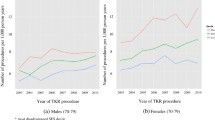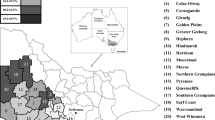Abstract
Summary
Compared to urban residents, those in rural/regional areas often experience inequitable healthcare from specialist service providers. Independent of small between-area differences in utilisation, socially advantaged groups had the greatest uptake of joint replacement. These data suggest low correlation between ‘need’ vs. ‘uptake’ of surgery in rural/regional areas.
Background and purpose
Compared to urban residents, those in rural and regional areas often experience inequitable healthcare from specialist service providers, often due to geographical issues. We investigated associations between socioeconomic position (SEP), region of residence and utilisation of primary total knee replacement (TKR) and/or total hip replacement (THR) for osteoarthritis.
Design and methods
As part of the Ageing, Chronic Disease and Injury study, we extracted data from the Australian Orthopaedic Association National Joint Replacement Registry (2011–2013) for adults that utilised primary TKR (n = 4179; 56% female) and/or THR (n = 3120; 54% female). Residential addresses were matched with the Australian Bureau of Statistics (ABS) 2011 census data: region of residence was defined according to local government areas (LGAs), and area-level SEP (quintiles) defined using an ABS-derived composite index. The ABS-determined control population (n = 591,265; 51% female) excluded individuals identified as cases. We performed multilevel logistic regression modelling using a stratified two-stage cluster design.
Results
TKR was higher for those aged 70–79 years (AOR 1.4 95%CI 1.3–1.5; referent = 60–69 years) and in the most advantaged SEP quintile (AOR 2.1, 95%CI 1.8–2.3; referent = SEP quintile 3); results were similar for THR (70–79 years = AOR 1.7, 95%CI 1.5–1.8; SEP quintile 5 = AOR 2.5, 95%CI 2.2–2.8). Total variances contributed by the variance in LGAs were 2% (SD random effects ± 0.28) and 3% (SD ± 0.32), respectively.
Conclusion
Independent of small between-LGA differences in utilisation, and in contrast to the expected greater prevalence of osteoarthritis in disadvantaged populations, we report greater TKR and THR in more advantaged groups. Further research should investigate whether more advantaged populations may be over-serviced.

Similar content being viewed by others
Change history
09 July 2018
The names of the co-authors Steven Graves and Michelle Lorimer were missing from the manuscript supplied for publication. The lead authors regret this error and apologize for any inconvenience.
References
Banks E, The 45 and Up Study Collaborators (2008) Cohort profile: the 45 and up study. Int J Epidemiol 37:941–947
AIHW (2008) Rural and remote health: indicators of health status and determinants of health. Rural Health Series Number 9. Australian Institute of Health and Welfare, Canberra
Romanow RJQ (2002) Building on values: the future of health care in Canada, Final Report. National Library of Canada; Commission on the Future of Health Care in Canada, Canada
Hartley D (2004) Rural health disparities, population health, and rural culture. Am J Public Health 94:1675–1678
Thomas S, Wakerman J, Humphreys JS (2015) Ensuring equity of access to primary health care in rural and remote Australia—what core services should be locally available? Int J Equity in Health 14:111
NRHA (2014) Income inequality experienced by the people of rural and remote Australia: submission to the senate inquiry into the extent of income inequality in Australia. National Rural Health Alliance, Canberra
Kirkhorn S, Greenlee RT, Reeser JC (2003) The epidemiology of agriculture-related osteoarthritis and its impact on occupational disability. Wisconsin Med J 102:38–44
Andersen S, Caspar-Thygesen L, Davidsen M, Helweg-Larsen K (2012) Cumulative years in occupation and the risk of hip or knee osteoarthritis in men and women: a register-based follow-up study. Occup Environ Med 69:325–330
Sajjad MA, Holloway KL, Kotowicz MA, Livingston PM, Khasraw M, Hakkennes S, Dunning TL, Brumby S, Page RS, Pedler D, Sutherland A, Venkatesh S, Brennan-Olsen SL, Williams LJ, Pasco JA (2016) Ageing, chronic disease and injury: a study in western Victoria (Australia). J Public Health Res 5:81–86
AOANJRR (2009) Demographics of hip and knee arthroplasty. AOANJRR, Adelaide, pp 1–33
Brennan SL, Stanford T, Wluka AE, Page RS, Graves SE, Kotowicz MA, Nicholson GC, Pasco JA (2012) Utilisation of primary total knee joint replacements across socioeconomic status in the Barwon Statistical Division, Australia, 2006-2007: a cross-sectional study. BMJ Open 2:e001310
ABS (2011) Australian statistical geography standard (ASGS): volume 3—non ABS structures July 2011. Cat: 1270.0.55.003. ABS, Canberra, Aust
StataCorp (2013) Stata statistical software: release. StataCorp LP, College Station, Texas, p 13
AIHW (2007) A picture of osteoarthritis in Australia 2007. Australian Institute of Health and Welfare, Canberra
Brennan SL, Lane SE, Lorimer M, Buchbinder R, Wluka AE, Page RS, Osborne RH, Pasco JA, Sanders KM, Cashman K, Ebeling PR, Graves SE (2014) Associations between socioeconomic status and primary total knee joint replacements performed for osteoarthritis across Australia 2003-10: data from the Australian Orthopaedic Association National Joint Replacement Registry. BMC Musculoskelet Dis 15:356
Kelleher J (2002) Cultural literacy and health. Epidemiology 13:497–500
Johnson A (2014) Health literacy, does it make a difference? Aust J Adv Nursing 31:39–45
Sanders C, Donovan JL, Dieppe PA (2004) Unmet need for joint replacement: a qualitative investigation of barriers to treatment among individuals with severe pain and disability of the hip and knee. Rheumatology 43:353–357
Clement ND (2013) Patient factors that influence the outcome of total knee replacement: a critical review of the literature. OA Orthop 1:11
Hawker GA, Wright JG, Glazier RH, Coyte PC, Harvey B, Williams JI, Badley EM (2002) The effect of education and income on need and willingness to undergo total joint arthroplasty. Arthrit Rheum 46:3331–3339
Smith SK, Dixon A, Trevena L, Nutbeam D, McCaffery KJ (2009) Exploring patient involvement in healthcare decision making across different education and functional health literacy groups. Soc Sci Med 69:1805–1812
Skinner J, Weinstein JN, Sporer SM, Wennberg JE (2003) Racial, ethnic, and geographic disparities in rates of knee arthroscopy among Medicare patients. N Engl J Med 349:1350–1359
Brennan-Olsen SL, Page RS, Lane SE, Lorimer M, Buchbinder R, Osborne RH, Pasco JA, Wluka AE, Sanders KM, Ebeling PR, Graves SE (2016) Few geographic and socioeconomic variations in primary total shoulder arthroplasty: a multi-level study of Australian registry data. BMC Musculoskelet Dis 17:291
Acknowledgements
We would like to thank the AOA NJRR team, particularly Michelle Lorimer, for providing access to these data. The data from the AOA NJRR were used with permission. The dataset supporting the conclusions of this article are governed by the AOA NJRR (https://aoanjrr.sahmri.com/).
Funding
This study is funded by the Western Alliance Academic Health Science Centre, a partnership for research collaboration between Deakin University, Federation University and 13 health service providers operating across western Victoria. SLB-O and LJW are each supported by a NHMRC Career Development Fellowship (1107510 and 1064272, respectively). KLH is supported by an Alfred Deakin Postdoctoral Research Fellowship, Deakin University. MAS is supported by a Deakin University stipend via the IMPACT Strategic Research Centre.
Author information
Authors and Affiliations
Contributions
SLB-O conceived the study and drafted the manuscript. SV undertook the analyses. All authors were involved in the study design and contributed to the interpretation of the background data; all authors provided critical appraisal of the manuscript for important intellectual content; and all authors approved the final manuscript.
Corresponding author
Additional information
Significance for public health
The social and geographic patterning of primary TKR and THR surgery, and any relationships with age and sex, has not been described for this region. This study links data from Ageing, Chronic Disease and Injury (ACDI) study to the Australian Orthopaedic Association National Joint Replacement Registry, which is the most complete and extensive set of joint replacement data in Australia. This information is particularly important because the need for elective surgery, such as joint replacement for advanced osteoarthritis, may not correlate with the uptake of surgery for residents in these areas. Furthermore, osteoarthritis is more prevalent in rural and farming communities compared to the general population, due to risk factors specific to agricultural and farming activities, including biomechanical stress related to repetitive forceful activities.
Electronic supplementary material
ESM 1
(DOCX 13 kb)
Rights and permissions
About this article
Cite this article
Brennan-Olsen, S., Vogrin, S., Holloway, K.L. et al. Geographic region, socioeconomic position and the utilisation of primary total joint replacement for hip or knee osteoarthritis across western Victoria: a cross-sectional multilevel study of the Australian Orthopaedic Association National Joint Replacement Registry. Arch Osteoporos 12, 97 (2017). https://doi.org/10.1007/s11657-017-0396-2
Received:
Accepted:
Published:
DOI: https://doi.org/10.1007/s11657-017-0396-2




